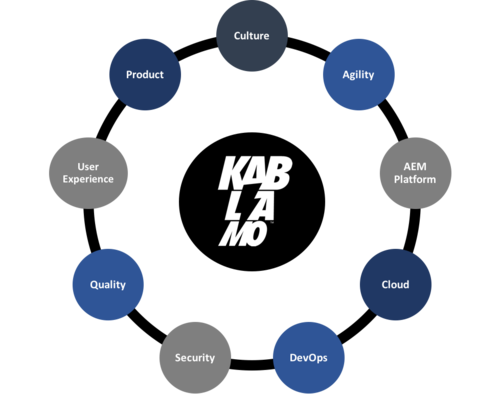
COMMONHURDLESOFDIGITALTRANSFORMATIONINENTERPRISE...ANDVALUABLELESSONSLEARNED
Over 9 months, leading the Digital Team within a major enterprise business, we learned many lessons. Here is an overview of three of the key hurdles we faced.
AUTHOR: Allan Waddell - CEO and Founder Allan (Founder and CEO of Kablamo), is a 15-year veteran of the digital industry. He’s borne witness to the booms - and survived the busts - of the digital advertising rollercoaster. As a result, he has a forensic focus on commercially viable, valuable digital strategy and execution.
Over 9 months, leading the Digital Team within a major enterprise business, we learned many lessons. Below is an overview of three of the key hurdles we faced (and overcame) - all of which are too common in enterprise businesses. Sharing these valuable lessons should prove useful to anyone looking to bootstrap an enterprise digital program.
1. Building Technical Skill to Select and Govern Vendors To engage vendors providing bespoke technical services, there are some non-trivial constraints that the business must be aware of and prepared for.
Simply engaging the apparent ‘best-dressed’ or obvious vendor applicant is not sufficient. Vendor Managers are required to have intimate knowledge of the bespoke technology at hand, to be able to vet and select vendors for technical capability. Furthermore, the company must be able to suitably assess the resulting technical solutions.
Where a single partner is required to deliver a solution end-to-end, that selected partner needs advanced skills with experience design, Adobe Experience Manager and Amazon Web Services. This collection of skills is rare. Many vendors will claim to have all three competencies, but few could deliver well on just one.
Opportunities to exploit digital systems and technology are rapidly and continually expanding. Maintaining close relationships with both Adobe and AWS is absolutely crucial to ensuring your company stays on top capabilities as they’re made available.
Fig 1.1 Competencies required to deliver a digital product:

2. Aligning to a Broader Cloud Strategy - with Collaboration Keeping execution of Product and Marketing strategy nimble, is a challenge, even in the most agile of business environments.
- Well-built cloud applications, coupled with a clearly articulated IT service delivery process, is the essential baseline for enabling rapid solution delivery.
- Marketing products such as Adobe and Salesforce function most effectively within these parameters.
- Product and Marketing teams frequently require a jump-ahead of a company’s internal technology strategy, limiting IT from providing long-term, consistently supported, robust solutions that meet evolving industry standards.
Digital teams are often under pressure to rapidly deliver new or enhanced products and services to meet market demand. As a result, they consistently challenge IT teams, who traditionally are not set up to support either the technologies, or the pace, at which they’re required.
In these scenarios, IT needs to be seen as an enabling (not restricting) force. A strong trust-based relationship between the two teams is required. The Digital team needs to work collaboratively with the IT team, transferring knowledge and skills as the execution plays out.
This close working relationship brings multiple benefits to the business:
- Up-skilling employees with new technologies and services;
- Enabling rapid handover of IP; and
- Ensuring the business is not locked into any single, specific vendor in the long term.
Fig 1.2 Kablamo In-Project Training / Collaboration Model

3. Creating a Product Development Framework for Efficient Execution Rapidly delivering meaningful customer outcomes is not easy in an environment where stakeholders have competing KPIs. A clearly defined and articulated Product Development Framework (PDF) is required to better manage possible conflicting priorities and stakeholder expectations.
At minimum, the PDF should include:
- Team engagement policies, and
- Feature prioritisation practices
However, the PDF can also address:
- Feature-inception and requirement analysis,
- Cost/benefit and ROI analysis,
- Rapid development methodology,
- User testing processes, and
- Design methodology (eg. Human-Centred Design).
For a robust and healthy software engineering practice, product development should be executed in lock-step - with highly efficient product development keeping pace with technical development activity. User experience decisions and assets should flow seamlessly into technical delivery. With user testing being conducted alongside, there should be confidence in the quality of the user experience. Post launch, it is crucial to have relevant analytics available to ensure educated decisions can be made regarding the direction of the product roadmap and new features.
In summary, the necessary skills and process should be addressed from the get-go of any digital initiative. As we discovered, ticking these boxes early on, goes a long way to drive successful customer outcomes. Finally, combine this strategy with a collaborative IT (DevOps) approach to achieve long-term product stability.